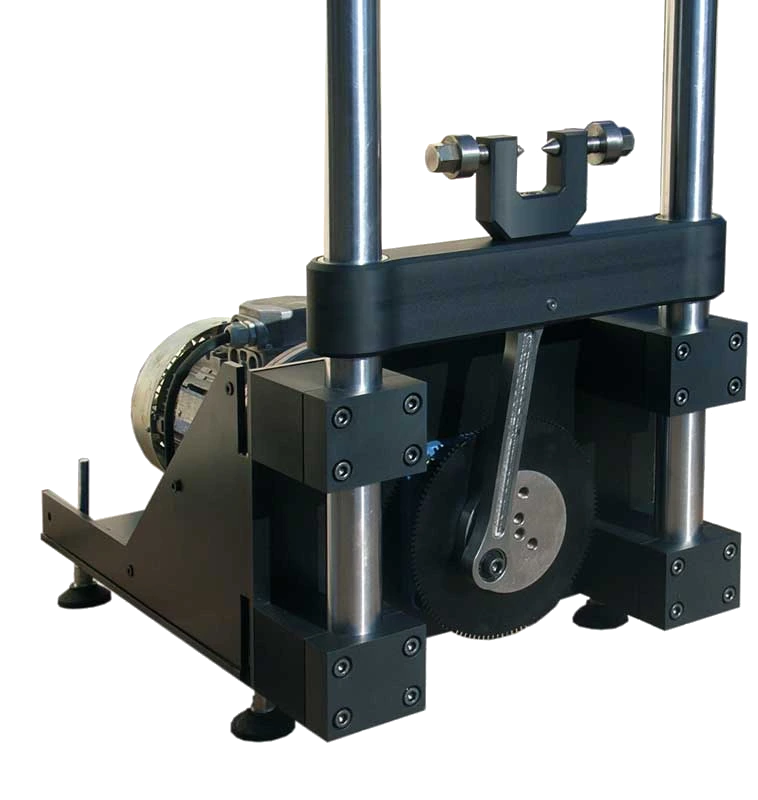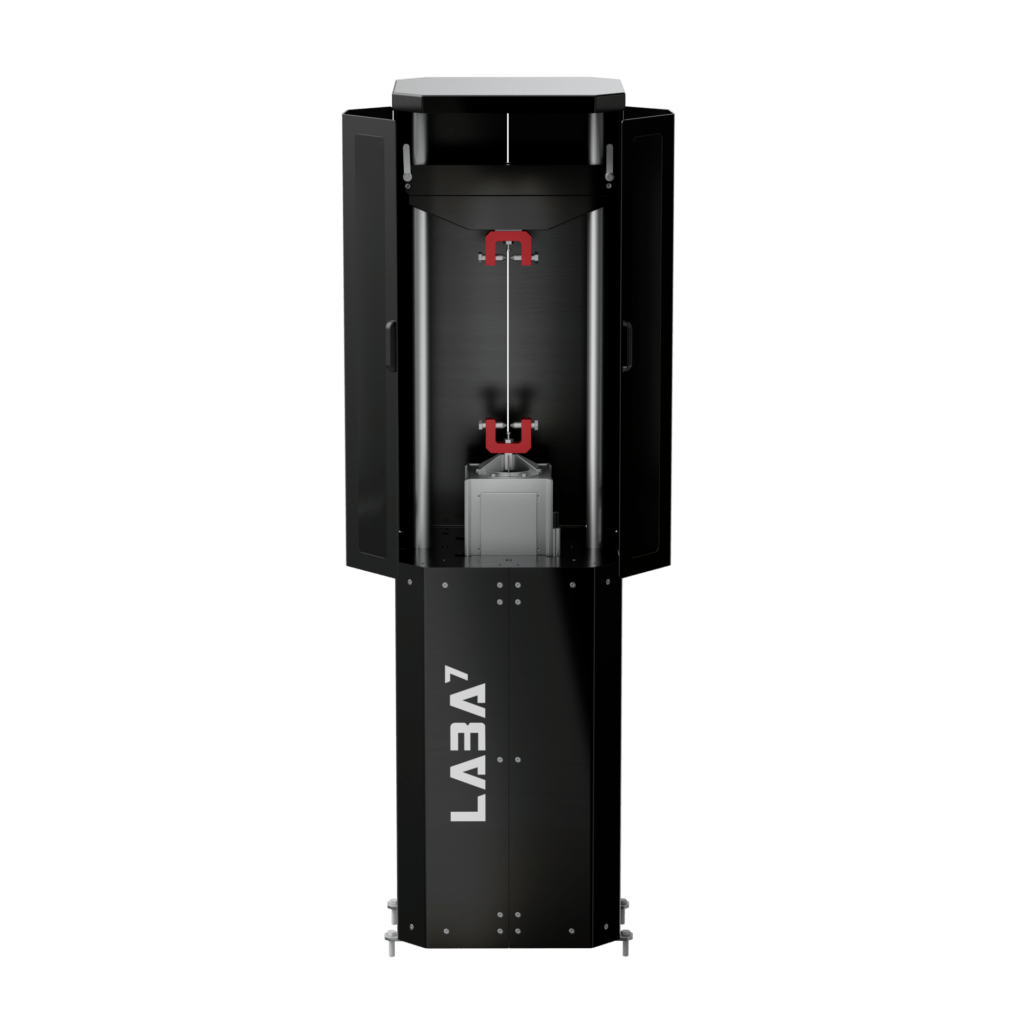Shock dynos play a crucial role in evaluating the performance and durability of shock absorbers and dampers. These dynos simulate real-world conditions and provide valuable insights into how a vehicle’s suspension system performs under different circumstances.
In this article, we will delve into the different types of shock dynos available, highlighting their advantages and disadvantages.
Table of Contents:
- Types of Shock Dynamometers
- Making use of shock dynos
- What are the best shock dynos?
- Shock dyno adapters
Types of Shock Dynamometers
Scotch-Yoke Dyno, Pros & Cons
Scotch-Yoke Dynos are probably the most popular type of shock dynamometers. As the name suggests, they utilize a scotch-yoke mechanism to simulate the forces experienced by a suspension system.
Currently, all LABA7 shock dynos are based on this design. It is accurate, reliable, and offers enough versatility to satisfy the needs of suspension workshops, manufacturers, and racing teams.

In general, Scotch-Yoke shock dynamometers have these advantages:
- Scotch-Yoke Dynos features a relatively simple mechanical design that converts rotary motion into linear motion. In this case, simplicity translates to reliability and repeatable results without a need to service the device often.
- These dynos tend to be compact, making them suitable for testing applications with limited space availability. Their smaller footprint allows for easy integration into existing testing setups or facilities. For example, some of our clients installed Featherlight shock dynos on their trucks to test dampers during race days.
- Scotch-Yoke Mechanism Dynos often offer a cost-effective solution for testing suspension components. Their simpler design and lower complexity contribute to reduced implementation and maintenance costs compared to other types of dynos. If you are looking for an affordable shock dyno for sale, you have come to the right place. Visit the Shock Dyno page for more information.
- This type of dyno is versatile and can test almost any kind of shock absorber. In our experience, there was no case, when our dyno could not meet the requirements of a potential customer. The biggest dyno in our lineup – Heavy shock dyno – can test any damper from MTB forks to shocks of truck racing in the Dakar Rally.
- They are very easy to use and require relatively little training before the operator is ready to test their first shock absorbers.
However, Scotch Yoke Mechanism Dynos also have certain limitations:
- These dynos may have limitations in replicating a specific range of force profiles and road conditions. For example, it could not recreate the forces shocks experienced on a certain track, like Nurburgring or Spa. Here at LABA7, we address this limitation by offering adjustable strokes.
- Scotch-Yoke Dynos typically have lower load capacity compared to hydraulic or electromagnetic dynos, but at the same time, they cost significantly less.
Besides advantages and limitations, there is one more item to mention that does not fall into any of the categories. This is just how Scotch-Yoke or Crank dynos work:
Based on their designs, both types of dynos can research only the “sinusoidal” movement. It means, that if you apply 1 m/s to the compression you have to reach the same on the rebound. And the system can’t stop after a one-way stroke – you can’t see what’s going on with the damper after compression because the system extends it immediately.
Furthermore, on both dynos you have smooth acceleration. The system speeds up the damper to target velocity and slows down after the target is met.
As mentioned before, this is neither a limitation nor an advantage. Simply, this is how these types of dynos work.
Crank Dyno, Pros & Cons
Also known as Crank-Based Shock Dyno or Crankshaft Shock Dyno. From a design perspective, it is very similar to Scotch-Yoke Dynos.
To be honest, the Pros and Cons of these two types are rather similar, the only big difference being accuracy. Crank Shock Dynos are less balanced and thus less accurate.
While Scotch-Yoke Dynos utilize the Scotch-Yoke Mechanism to translate rotary motion into linear motion, Crank Shock Dynos fit shock absorbers directly to the crank.

This means that during the test, the shock absorber moves not only up and down, but side to side as well. This creates additional forces that impair the accuracy of the dyno. Check this video for a visual demonstration: Scotch yoke versus slider-crank oscillation mechanism.
To cancel out these forces, some manufacturers develop filters in their software. From the experience of our customers who used such devices before, it is not a perfect solution. The results of the tests are less accurate and less dependable. Which is not great when you put your reputation or podium wins on the line.
Processing data is not bad in itself. Sensitive data loggers can pick up electric noise from the environment that should be canceled out. But in general, less processing means more accurate results and shock dyno graphs.
This is a critical topic and we will write a dedicated post about data processing in the future, meanwhile, visit this article on how to read shock dyno graphs. It covers what dyno graphs LABA7 shock dynos generate and what they mean.
Electromagnetic Actuator Dyno, Pros & Cons
Want to know, how your shocks would perform through the course Nurburgring? Electromagnetic shock dynos are perfect for you.
They utilize magnetic fields to generate controlled forces and simulate real-world conditions. In general, they are extremely accurate and allow operators to recreate the exact forces that would act on the dampers on specific tracks.

Electromagnetic dynos offer unique advantages:
- Electromagnetic dynos provide precise force control, allowing for accurate replication of different road conditions. This level of control enables detailed analysis of shock absorber performance and fine-tuning of suspension setups.
- They can be used as specific dyno machines to research friction and complex momentum. Not only to simulate track but also to develop internal components of the damper with multi-sinusoidal movement or impact. Or even use different speeds for compression and rebound during testing. For example – the standard friction test is a cycle of the following steps at stroke 100mm: compression 0,3 m/s for 45 mm -> compression 0,001 m/s for 10 mm -> compression 0,3 m/s for 45 mm, and the same goes for rebound.
- Unlike hydraulic dynos that require continuous power input, electromagnetic dynos consume power only when generating forces. This energy efficiency translates into reduced operating costs over the long term.
- Electromagnetic dynos have relatively lower maintenance requirements compared to hydraulic ones. They do not rely on hydraulic fluids, eliminating the need for fluid changes and associated maintenance tasks.
However, electromagnetic shock dynos also have their limitations:
- They are very good, but not what one could call cheap. These machines are much more accurate and complex than Crank or Scotch-Yoke Dynos, but they come with a price. Literally.
Hydraulic Shock Dyno, Pros & Cons
Hydraulic Shock Dynos rely on hydraulic fluid to simulate the forces experienced by a vehicle’s suspension system during different driving scenarios.
These dynos offer several benefits:
- Like Electromagnetic Shock Dynos, Hydraulic shock dynos can accurately replicate road conditions by generating precise force profiles that mimic various driving scenarios.
- Hydraulic dynos are known for their high load capacity, making them suitable for heavy-duty applications. They can handle substantial force inputs, ensuring reliable results.
However, hydraulic shock dynos also have some limitations:
- All equipment with high-pressure hydraulics is very dangerous and hydraulic shock dynos are no exception. The main problem of hydraulic dyno is a line break – an explosion that can be quite hazardous to the operator and surroundings. So, safety regulations are much more complicated.
- Hydraulic dynos require regular maintenance, including fluid changes and seal replacements, to ensure accurate and consistent performance as well as the safety of people and other equipment. Additionally, they can be expensive to install and operate, making them less accessible for smaller testing facilities.
- The use of hydraulic fluid raises environmental concerns due to potential leaks or spills. Proper containment and disposal practices are necessary to mitigate these risks.
Making use of shock dynos
Just like any other tool in life, shock dynos are as useful as you are making the best of them. If the tool is difficult to use or provides information that is not clear, it is not useful.
For example, you could have an amazing Ferrari 812 GTS in your garage, but if you cannot drive, start the motor, or even open the door, what is the use of it? Well, apart from aesthetic pleasure it is simply beautiful to look at.
The same goes for shock dynos. If you do not use them, they will become expensive decorations.
Here software comes into play. The easier it makes to use the machine, the clearer data it provides, and the more you will make out of your shock dyno. That is our philosophy of shock dyno software development.
Proper Software is a guide in damper measurement knowledge.
Said by a friend of LABA7
So, when choosing the shock dyno, consider if the software is easy enough to use and the dyno is easy enough to operate.
Check out the Understanding shock dynos article where we get into more detail about the software, data loggers, and load cells.
What are the best shock dynos?
In our opinion, the best options are Scotch-Yoke (SYD) and Electromagnetic shock dynos (EMA). SYDs offer superior accuracy than crank shock dynos for the same price. At the same time, EMAs deliver the same power and speed as hydraulic shock dynos but are much safer, quieter, and more efficient.
These two machines are so different that they are almost incomparable. But we did it anyway. You can read this blog post for more: Electromagnetic linear actuator vs Scotch-Yoke shock dyno.
Shock dyno adapters
Shock dyno is becoming inseparable from quality service. Here, at LABA7, we understand the urge for versatility in the automotive realm. Thus, we have developed dedicated adapters for automobiles, motorcycles, and mountain bikes.
Shock dyno adapters for AUTO
Well-maintained shock absorbers are essential to ensure safe, accurate, and comfortable rides with either a daily or sports car. That’s easier to achieve with specialized tools, including shock dyno adapters for AUTO. When developing them, we made sure to provide you with the possibility of mimicking the closest to the real-world scenarios possible.
For those who need a seamless shock absorber testing process, there’s a Self-preload clevis available for €200. With it, you will easily mount and dismount dampers, and you can also asses shocks that come with expansion tanks.
Another versatile option is a rod-end AUTO adapter, which comes in 6 possible threads that are individually made according to the customer’s request. The price per single adapter is €100. If you also work with MacPherson struts, its adapter is available for €150.
Shock dyno adapters for MOTO
Specialized shock dyno adapters for motorcycles are crucial for optimizing the vehicle’s performance. Whether you ride for leisure or participate in races, a well-calibrated damper is a key component. Using the appropriate shock dyno adapter allows you to prepare the motorcycle for the specific conditions you’ll face on the road.
At LABA7, we have three different types of damper dyno MOTO adapters. For testing your motorcycle’s shocks, there’s a Self-preload clevis, which allows you to mount and dismount a damper both at the top and bottom effortlessly. This is a flexible and also budget-friendly option, costing as low as €200.
There is also an adapter to asses motorcycle forks that supports 54, 55, and 56 mm forks. In case you need an adapter for other diameter forks, custom inserts are available and cost equally to pre-made ones – €600. Aside from the previously mentioned adapters, you can get a set of 10 adapters for motorcycle cartridges both top and bottom for €800.
Shock dyno adapters for MTB
Last but not least: shock dyno adapters for MTB. As bicycle sports continue to gain popularity, the ability to service various mountain bikes is crucial for success as a bicycle mechanic. As enthusiasts of bicycle sports ourselves, we have designed two types of adapters for smooth shock absorber testing.
There’s a Self-preload clevis for €200, which allows you to mount and dismount dampers both at the top and bottom quickly and easily. For testing your shock absorbers without stopping, we have made a Trunnion adapter, which lets you attach and detach shock absorbers during tests securely for only €210.
The other two types of adapters include ones for mountain bikes’ forks and cartridges. The MTB fork adapter supports three different inserts (100 x 15, 110 x 15, and 110 x 20 mm) and costs €430. As for cartridges, you can purchase a set compatible with RockShox, Ohlins, and Fox cartridges for €800. Moreover, you can get an adapter that works with SR Suntour cartridges for an additional €400.
—
Thank you for visiting this article about different types of shock dynos and their most important parts! You also might like this article about finding the best shock dyno for sale.
You also might like these articles:

